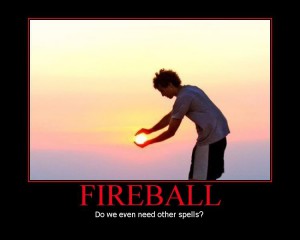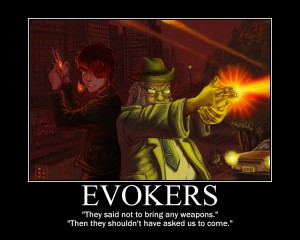I was asked about this, and what was a short email became a blog post. Fighters in D&D 5 have a number of choices to make quite early in their character development, so let’s examine them in a bit more detail.
Fighting Style
The first choice is what fighting style to take. For the sake of this particular discussion, I’m ignoring the fighting styles that don’t boost damage in some way, although they’re certainly worth considering (Protection in particular is rather powerful). We’re going to be examining these using Kodra’s assumption of 15 AC as a decent target, and a 16 in the primary attack stat.
- Archery: This is a +2 to hit, or a flat 10% increase in your chance to hit (advantage/disadvantage can mess with that a bit). Longbow damage is therefore going to be .6(7.5)+.05(12) = 5.1 DPR at level 1. Fighters don’t get any thing that directly boosts this until their subclass choice, but that’s for later. No other style provides a boost to hit, so this one provides the most consistent damage.
- Dueling: This would seem to be the default choice, but our DM has ruled that it doesn’t apply to sword and board. Anyway, at +2 to damage modeling this is also pretty straightforward: .5(9.5)+.05(14) = 5.45 DPR. Not bad, and it gives you a free hand to work with (which might be important depending on later choices).
- Great Weapon Fighting: The important note here is that if you’re in this category, you’re probably planning to use the King of Weapons, the Greatsword, as it’s the objectively most damaging weapon in the book (although the Maul got moved up to match it). As such, this would come out ahead of the Dueling numbers without taking the style (5.85) but the style is another damage boost on top of this. The end result (assuming that you always reroll an initial roll of 1 or 2) is 6.65 DPR.
- Two-Weapon Fighting: This should probably be evaluated differently because hitting with both hands requires your bonus action, but as a low-level fighter you don’t have any other uses for that anyway. This also requires light melee weapons (without a feat), which means you’re down to shortswords (or similar). Final damage is (.5(6.5) + .05(10))*2 = 7.5. This lead decreases when Extra Attack comes into play.
Martial Archetype
The choice between these really depends on what you want to do with your fighter. One thing to keep in mind is that fighters are still mostly supposed to use their weapons on things, and this remains true even if you’re a Battle Master or Eldritch Knight.
Champion
This one’s definitely the most straightforward. More criticals, another fighting style, and some bonuses to checks you’re probably not doing a lot (although it’s worth noting Remarkable Athlete does cover stealth checks if you don’t have proficiency). I don’t quite have Kodra’s patience for calculations, so I’ll trust him when he says that the critical bonus isn’t worth that much at low levels. The additional fighting style can be used either for defense or versatility. This archetype gives nothing that uses a bonus action, so TWF works fine with it.
Battle Master
All of the things people liked about the 4e Warlord ended up here, except constrained by a limited pool of superiority dice (which are recovered in a short or long rest). Many of the maneuvers you can pick from allow you to add the superiority die roll to the damage of an attack, making it better for damage than Improved Critical (as long as your dice last). Some of these require you to use a bonus action, making TWF a less attractive option for this archetype. There are other interesting things you can do in this one, like getting an off-turn sneak attack out of a rogue in the party if you have one (requires your bonus action and the target’s reaction). Once you run out of superiority dice, this archetype doesn’t have much to offer, but I know it’s Kodra’s favorite.
Eldritch Knight
This one’s a bit odd. The paragraph at the start of the archetype description hints at where this one is going, and what it gives you. While it does grant cantrips, they’re less likely to hit than weapon attacks unless your INT is abnormally high for a fighter (maybe you rolled for stats; consider Blade Ward if you’re more… typical) and will also do less damage in most cases (especially if you’re using a greatsword). The primary power here is access to one of the better Wizard defensive spells (Shield is very good) and some AOE that other fighters cannot duplicate (look for spells that still deal half-damage on a successful save like Burning Hands, or later, Fireball). At much later levels, you can start taking other wizard buffs, like Haste or Stoneskin. Spell slots are limited, so the primary thing you’ll be doing is still using your weapon. Because casting most spells requires a free hand, and later features do use your bonus action, TWF is a no-go for this archetype. Jury’s still out on if you can cast spells with a two-hander, so check with your DM. (I’d say yes, but it’s not entirely clear.) I personally think this might be the best archetype for “tank” type fighters.
Conclusion
That’s a lot of words to say “different choices work better in different situations”. Unlike Ranger, where I firmly believe one of the archetypes is weaker than the other, the fighter ones are all good in their own way. The Fighting style question is a little easier, as Great Weapon is great unless you have compelling reason not to use it (dex-based fighter, want protection style, etc.). Hope this helps anyone who’s intending to play a fighter in an upcoming game!
You know what this link is by now. Also, you have until the end of the weekend to finish the Four Job Fiesta. I apparently owe another $10 now.





